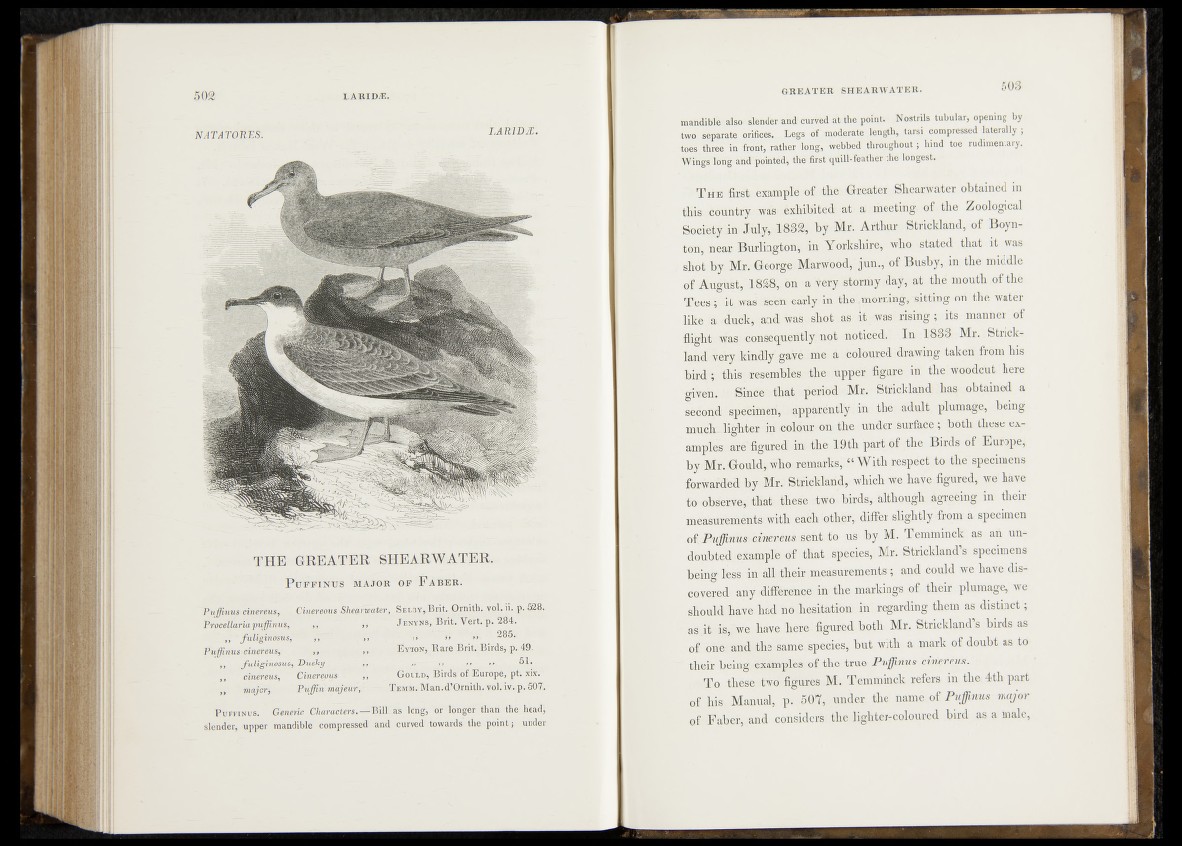
NAT A TORES. LAR1D2È.
T H E G R EA T ER SH EA RW A T ER .
PUFFINUS MAJOR OF FABER.
Puffinus cinereus, \Cinerepus Sheyrwa
Procellaria jpuffinus, ,, >>
. ' fuliginosus, " ,7 : , >
Pnffinuscinereus,- '?_..»■■---if-'; »
„ fuliginosus, Düsky. „
,, cinereus, Cinereous - „
„ major) Puffin majeur, - -
, S e l b y , Brit. Ornith. vol. ii. p. 528.
jENYN8,'Brit.'v|i'ri p. 284.'
E y t o n , R a r e B rit. B ird s, p. 49.
•••r 7 r—-i»: » » • 51* •
G o^ b , B ird s o f-E u ro p ê , p t; x ix .'
T emm. M a n .d ’Qixiith. Vol. iv. p . 507'.
Puffinus. Generic Characters.— WH^as long, or longer than the head;
slender, upper mandible compressed and curved towards the point; under
mandible also slender and curved at the point. Nostrils tubular, opening by
two separate orifices. Legs Of moderate length, tarsi compressed laterally;
toes three in front, rather long, webbed throughout; hind toe rudimentary.
Wings iong aridvpointêd, the first quill-feather the longest.
T h e first example of., the Greater Shearwater obtained in
tpsw&ejantry. • rwa!s éxhibited at a meeting of the Zoological
Soeie.tj.iin July,: 1832, by Mr. Arthur Strickland, of Boynton,
near Burlington; in Yorkshire, who stated that it was
shot by Mr. George, Marwood, jun., of Busby, in thé middle
of August, 1828,. on a véry stormy .day, at thé mouth of the
Tees; it wasiseinF- early in the .morning, sitting on the water
like „a /duck, and wasmot as it was rising; its manner of
flight was consequëntly/not noticed. In 1833 Mr. Strickland
very kindlyi ga jé me a coloured drawing taken from his
bird ; this -resembles the upper figure in: the, woodcut here
given. Smce'ithat period Mr. Strickland has obtained a
second specimen, apparently. in the adult, plumage, being
much-dighter in colour on the under Surface; both these examples;
are1 figured' imdhe 19.th part Of ^the. Birds of Europe,
by Mr.-,Gould, who remarks, “ With respect .to the specimens
forwarded, by Mr.' Strickland,- which ,we have .figured, we have
fo-obsërve, that these itwó birds, although igreêing in their
measurements with eaöh other, differ slightly from a specimen
o i Puffinus cinereus sent to us by M. Temtnmck as an undoubted
example of that Species, Mr. Strickland’s specimens
being less in all their measurements; and could we have discovered
any difference in-tfee, markings of their plumage, we
should have had no hesitation; in regarding them as distinct;
' aS it is,' we have here figured both Mr. Strickland’s birds as
of ohê- and the same .species, but with a mark of doubt as to
~ their being examples of the true Puffinus cinereus.
To these'two figures M. Temminck refers in the 4th part
of his Manual, p. 507, under the name of Puffinus major
of Faber, and considers the lighter-coloured bird as a male,